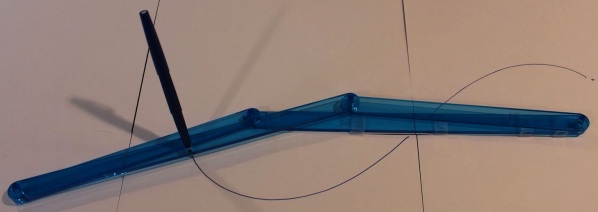Math Monday: Linkages, Part 8 – In Search of Straightness
by Glen Whitney
[sharethis]
In the second column in this series, we witnessed the incredible complexity that a simple four-bar linkage can create: it will, in general, draw a path described by a sixth-degree polynomial in x and y. But what about simpler functions, maybe much simpler? Can a linkage draw a linear path in x and y? It would seem to stand to reason, given the enormous flexibility. And this question, far from being just an academic one, was of tremendous practical significance — to none other than James Watt. As you may recall, he was engaged in an effort to build steam engines. And a key component of any steam engine is a piston. And in order to harvest the energy of the expansion of the steam, the piston head must be sealed very tightly, to force the steam to move the head, rather than just escaping. And to keep that piston head as tight as possible, how should that piston rod move? Precisely in a straight line along the axis of the piston. On the other hand, one wanted to take that back-and-forth motion and turn an axle with it. So there was a fundamental practical need to convert linear motion to rotary motion. Here’s the idea that Watt came up with, which he described as ” one of the most ingenious simple pieces of mechanics I have invented.” – and perhaps deservedly so, since prior to Watt, the conversion from linear to rotary motion could only be done with a chain. Since a chain can only be pulled, not pushed, that limitation meant that one direction of every stroke wasted its power.
Watt’s Linkage
Ingredients: A 34-bar with no other holes (A), two 24-bars (B and D), and one 34-bar with a hole at 17; four linkers, and a pen.
Directions: Link A to B to C0; link C34 to D and cross C over D as you link D back to A. Put a pen in C17.
To use: Anchor A, and rotate B and/or D to draw a figure-eight looking curve with the pen. Make sure to flip each joint in such a way as to head A and C toward crossing over each other, every time you reach a dead point.
Here’s the linkage built and partway through drawing: And here’s the completed curve:
And here’s the completed curve: In fact, this graceful curve had already been discovered by the mathematician Jacob Bernoulli almost a hundred years earlier, who dubbed it the “lemniscate”. He saw it as a sort of variation on an ellipse, in which the product of the distances of a point beginning at two fixed points remains constant, rather than their sum. Because of that product property, this path for a four-bar linkage is described by a fourth-degree polynomial, much simpler than the usual sixth-degree. Interestingly, the study of the lemniscate of Bernoulli later by Euler led to developments crucial to important areas of modern mathematics.
In fact, this graceful curve had already been discovered by the mathematician Jacob Bernoulli almost a hundred years earlier, who dubbed it the “lemniscate”. He saw it as a sort of variation on an ellipse, in which the product of the distances of a point beginning at two fixed points remains constant, rather than their sum. Because of that product property, this path for a four-bar linkage is described by a fourth-degree polynomial, much simpler than the usual sixth-degree. Interestingly, the study of the lemniscate of Bernoulli later by Euler led to developments crucial to important areas of modern mathematics.
But what has this elegant curve to do with Watt’s problem? The key lies in one stroke of the curve right near the center, where it crosses the fixed bar. The lemniscate is very nearly straight through that section. Watt adjusted the length-to-width ratio of this linkage to increase the length of that section so that the entire back-and-forth motion of the piston would lie within the almost-straight region, and modified it to get that region out of the way of the fixed bar, and was thus able to create the first steam engine which delivered power on both its upstroke and its downstroke.
However, also because of the product property, no section of the lemniscate is precisely straight, just very close. Is there a four-bar linkage that produces precisely straight motion? Or any linkage at all? This turned into a significant mathematical mystery lasting for many years, which we will examine in the coming installments. In the meantime, try your hand: can you make a linkage using the MoMath Linkage Kit which draws a perfectly straight line? (Only if you want to deprive yourself of the joy of exploration should you search the web to find out if it is possible…)
This article first appeared on Make: Online, October 15, 2012.












